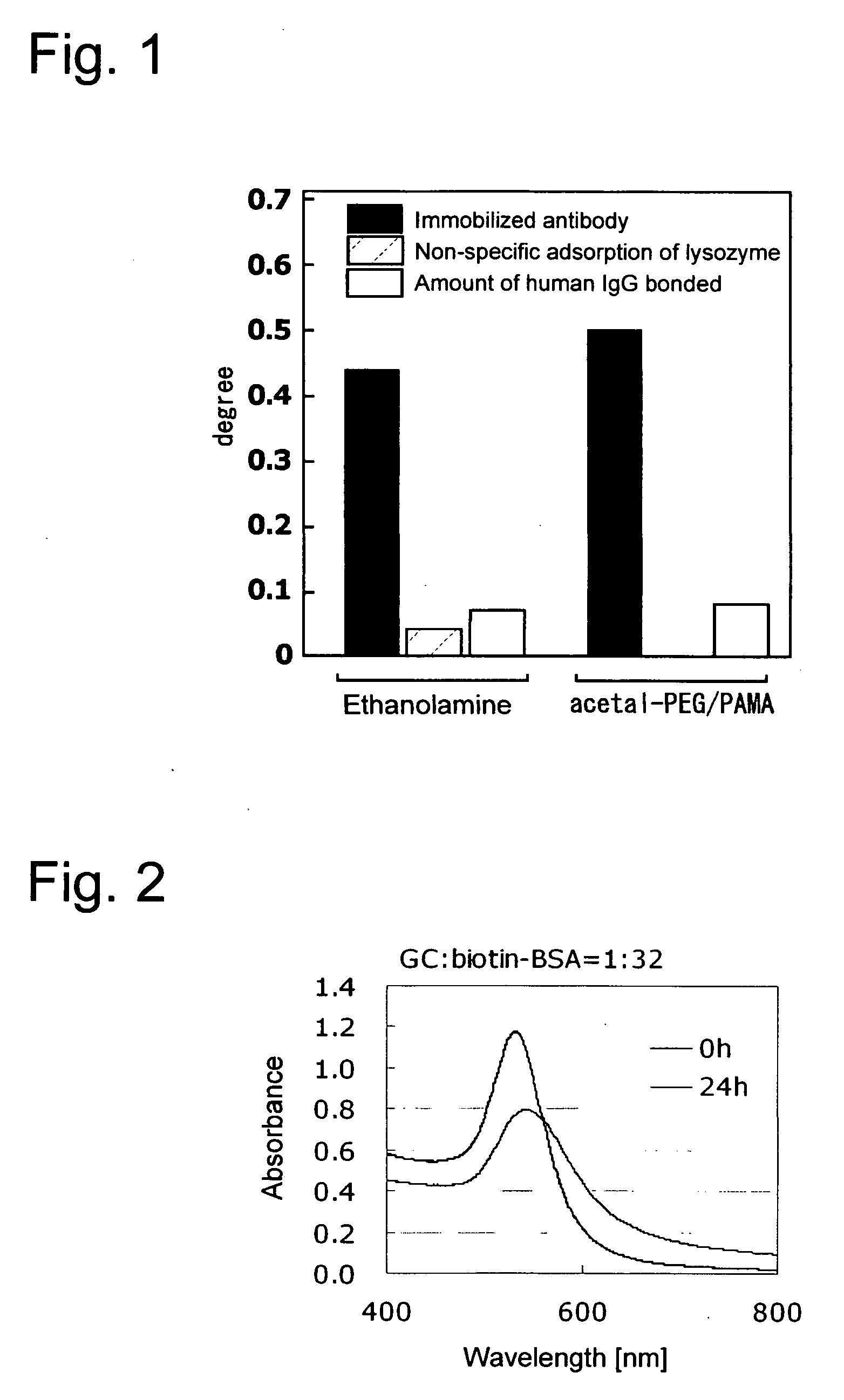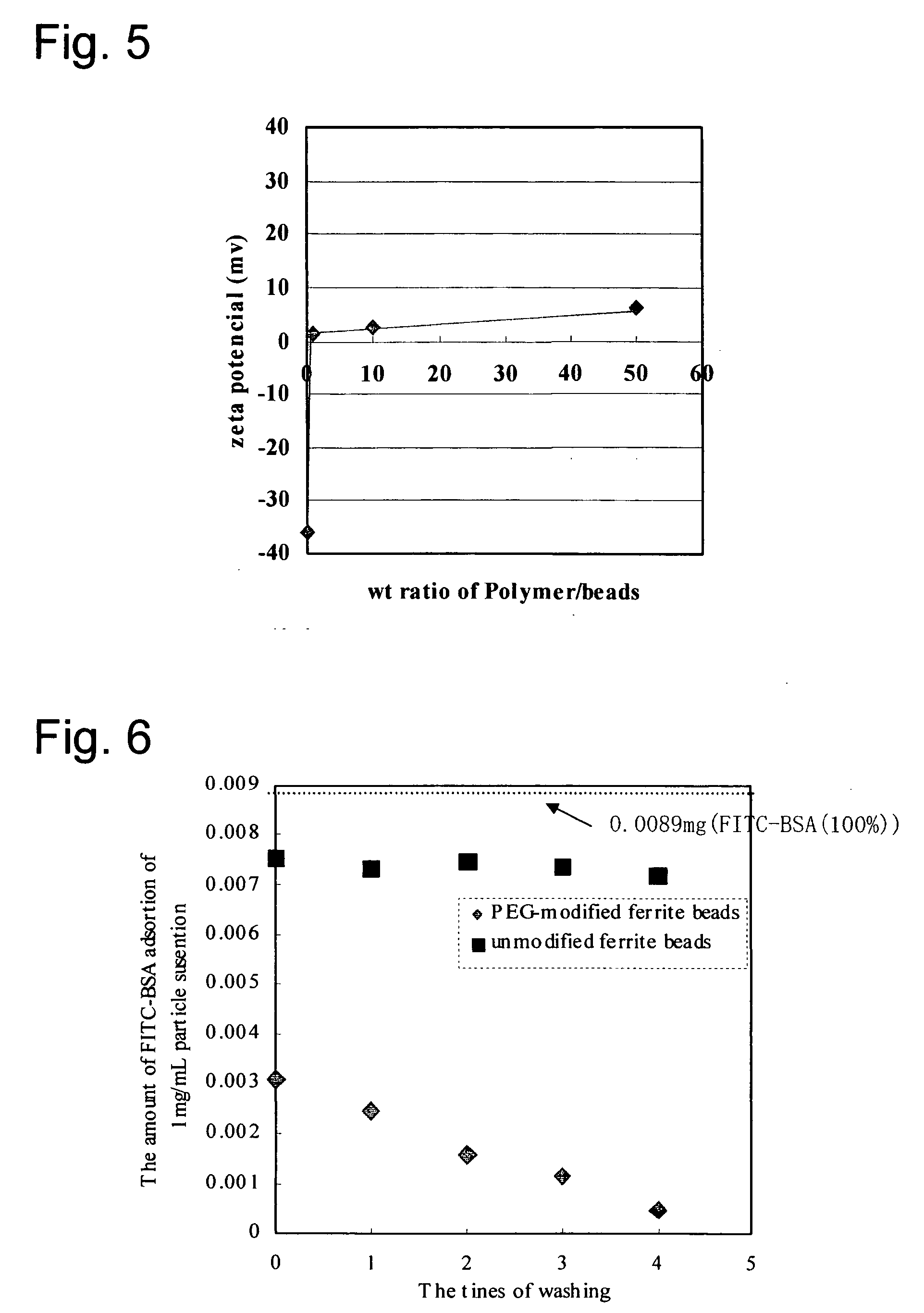Surface of base material being inhibited in non-specific adsorption
a technology of base material and non-specific adsorption, which is applied in the field of substrate surface, can solve the problems of background caused by non-specific adsorption but also dispersion stabilization in biological fluid or diluted liquid thereof, and achieve the effect of high sensitivity and easy preparation
- Summary
- Abstract
- Description
- Claims
- Application Information
AI Technical Summary
Benefits of technology
Problems solved by technology
Method used
Image
Examples
referential example 1
Production of Acetal-PEG-OH
[0051]
[0052] In an egg-shaped flask in an atmosphere of argon at room temperature, 1.0 mmol of 4-hydroxymethyl benzaldehydedimethyl acetal (1.822 mol / l—THF solution, 0.55 ml) as an initiator was added to 25 ml of tetrahydrofuran (THF) as a solvent with a microsyringe, and then, 1.0 mmol of K-naphthalene (0.328 mol / l—THF solution, 3.05 ml) was added, and, thus, metallization was conducted for 10 minutes. Then, 140 mmol of ethyleneoxide (6.9 ml) was added, and the resultant mixture was stirred for two days under water-cooling, and, thus, anion ring-opening polymerization was conducted. Several drops of pure water were subsequently added to stop the reaction, and, then, purification was conducted by diethyl ether precipitation (2 l), chloroform extraction (three times against saturated saline water), drying under reduced pressure and benzene freeze drying. The yield of thus obtained product was 4.5 g (90%).
[0053] According to measurement by gel permeation c...
referential example 2
Production of Benzaldehyde-PEG-OH
[0056]
[0057] In an egg-shaped flask, 1.0 g of acetal-PEG-OH obtained in the above was dissolved in 20 ml of 90% aqueous solution of acetic acid, and the resulting mixture was stirred for five hours. Subsequently, the mixture was adjusted to pH 8 with use of ION HCl, and was then dialyzed (molecular weight cut-off: 3500; water was replaced after 1, 2, 4, 6, 8 and 12 hours) against pure water for one day, and was subsequently subjected to drying under reduced pressure and benzene freeze drying, for recovery. The yield of thus recovered product was 0.88 g (88%).
[0058] According to measurement of gel permeation chromatography, the obtained polymer was monomadal, and had a number average molecular weight of 6,056 which almost agreed with theoretical molecular weight of 6,054.
[0059] Also measurement by MALDI-TOF-MS taught that the obtained polymer was monomadal, and had a number average molecular weight of 6,023. Moreover as a result of comparison betwe...
referential example 3
Production of PEHA-Phenyl-PEG-OH
[0061]
[0062] In 5 ml of methanol, 250 mg of benzaldehyde-PEG-OH was dissolved. An egg-shaped flask was fed with PEHA (5 mmol, 1.2 ml) in a molar amount 100 times as much as PEG, and, then, said PEHA was dissolved in 20 ml of methanol. The resultant mixture was adjusted to pH 6 with 5N HCl under ice cooling. To this PEHA methanol solution which was being vigorously stirred, benzaldehyde-PEG-OH methanol solution was slowly added dropwise. The resultant mixture was stirred at room temperature for four hours, and, thus, Schiff base was formed. Then, as a reducing agent, 5 mmol (a molar amount 100 times as much as PEG; about 300 mg) of NaBH3CN was added to the reaction solution three times in total at an interval of 30 minutes, and the resultant mixture was stirred for 24 hours. Thus obtained reaction solution was dialyzed (molecular weight cut-off 1000; water was replaced after 3, 6, 18, 24, 30, 42 and 48 hours) against pure water for two days. Subsequen...
PUM
| Property | Measurement | Unit |
|---|---|---|
| temperature | aaaaa | aaaaa |
| temperature | aaaaa | aaaaa |
| pH | aaaaa | aaaaa |
Abstract
Description
Claims
Application Information
 Login to View More
Login to View More - R&D
- Intellectual Property
- Life Sciences
- Materials
- Tech Scout
- Unparalleled Data Quality
- Higher Quality Content
- 60% Fewer Hallucinations
Browse by: Latest US Patents, China's latest patents, Technical Efficacy Thesaurus, Application Domain, Technology Topic, Popular Technical Reports.
© 2025 PatSnap. All rights reserved.Legal|Privacy policy|Modern Slavery Act Transparency Statement|Sitemap|About US| Contact US: help@patsnap.com



